 Image search results - "in" Image search results - "in" |
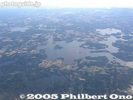
Finland: Land of Lakes 湖だらけの国When you look at a map of Finland or see it from the air, the first thing you notice is that it has a lot of lakes. Ten percent of the country is covered by lakes, but from the air over the southern half, it looks like least 30%-40% of the land is water.
It looked like a field of giant puddles or one giant marshland. It was like the country was sinking into ocean. I had never seen so many lakes in my life. Incredible. And if it's not water, it's forests. Some 70% of Finland is covered by forests.
I think Finland will someday become a popular tourist destination, especially for people who need to escape the urban hustle-bustle and stressful lifestyle. There are nothing like trees and lakes which can pacify humans.
Basic intro to Finland: http://virtual.finland.fi/
Finland map: Virtual Finland map
上空からも直ぐ分かるけど、フィンランドは湖がとっても多い国。20万弱の湖。面積の一割が湖。なんと国の7割は森林。湖と森林は、人を癒すものである。
HP: フィンランド政府観光局(日本語)
|
|

Letter of Thanks from PhilI really enjoyed my first trip to Finland during September 4-18, 2005 (Sept. 8-17 in Kuusamo) and savored every hour. The people in Kuusamo were all so nice and it was a great pleasure to meet and see the work of many talented and dedicated photographers from Europe.
They have definitely piqued my interest and opened my eyes to the nature and wildlife in northern Europe and the Arctic region. I've also become much more keenly aware of the seriousness of global warming. People in Finland have told me how the climate has become noticeably warmer over the decades. Such countries near the polar regions are the first to feel and see the detrimental effects of global warming. I really hope we can someday reverse the trend.
I want to thank the people who made my sponsored trip and participation in Kuusamo Nature Photo 2005 possible and very enjoyable. After months of email correspondence with the festival staff, it was great to finally meet all of them face to face. It makes a big difference when you know the face and person behind the name.
I know they worked very hard to pull off a very successful nature photo festival. For all the email correspondence, coordination, and making all the arrangements, I especially want to thank the following:
Lassi Rautiainen, Kuusamo Nature Photo Director
Pekka Pirhonen, Kuusamo Culture Department Manager
Seija Väisänen
Hannele Pappila
Town of Kuusamo
Corporate sponsors
I also want to personally thank the following people:
Pirkko Väätäinen, my interpreter who interpreted my three slide shows into Finnish.
Hannu Hautala and wife Irma, for having us over at his home/office. Despite his fame, Hannu is a very down-to-earth and warm-hearted man. It was a great pleasure to meet him, to see his collection of Japanese photo books, and hearing about his two trips to Japan.
Barbara, for videotaping my slide shows with my video camera and taking some great snapshots of me enjoying myself in Kuusamo. And also for providing transportation to/from the airport.
Tõnu Ling, for taking snapshots of me in Kuusamo and being my first friend in Kuusamo (we met on the plane to Kuusamo).
Koillis sanomat newspaper and reporter Tuomo Pirttimaa for interviewing me in an article they published.
Again, I have to thank Lassi for everything. He was the one who took care of all the details even during our nature trips. Lending sleeping bags, carrying hot drinks in heavy thermos bottles, driving us all over the place, answering all our questions, taking pictures of us, and making sure everyone had an enjoyable time. He turned out to be quite humorous. I can highly recommend him to anyone who needs a very knowledgeable local guide to watch or photograph wildlife in Finland.
See his Web site: Articmedia
Finally, I want to thank all the people and photographers I met at Kuusamo for their pleasant company and friendship. Remember that you have a friend in Japan. If you ever come and visit, let me know.
Meanwhile, I hope you enjoy this permanent online gallery of Finland photos explained in both English and Japanese.
Philbert Ono
Tokyo, Japan
P.S. In case you don't know, "kiitos" means thank you in Finnish.
|
|

Three-day (Aug. 9-11, 2006) rowing route around the southern half of the lake by the Kyoto Univ. rowing club.1st day: Home base in Seta River to Manohama (crew change), then to Omi-Maiko.
2nd day: Omi-Maiko to Manohama, then to Chomeiji.
3rd day: Chomeiji to Manohama where crew changes. Then to home base in Seta River.
|
|

My video of 2023 Koenji Awa Odori. 第64回高円寺阿波おどり
|
|

My video of 2018 Koenji Awa Odori 第62回高円寺阿波おどり
|
|

My video of 2017 Koenji Awa Odori (56 troupes) 第61回高円寺阿波おどり
|
|

My video of 2016 Koenji Awa Odori (56 troupes) 第60回高円寺阿波おどり 56連の総集編
|
|

My video of Koenji Awa Odori 2015 第59回高円寺阿波おどり 40連の総集編
|
|

My video of Koenji Awa Odori 2013 Part 1/3 第57回 東京高円寺阿波おどり 総集編
|
|

My video of Koenji Awa Odori 2013 Part 2/3 第57回 東京高円寺阿波おどり 総集編
|
|

My video of Koenji Awa Odori 2013 Part 3/3 第57回 東京高円寺阿波おどり 総集編
|
|

My video of Koenji Awa Odori 2011 Part 1/2 高円寺阿波おどり
|
|

My video of Koenji Awa Odori 2011 Part 2/2 高円寺阿波おどり
|
|

My video of Koenji Awa Odori 2009 Part 1/3 - Kokesaku 苔作
|
|

My video of Koenji Awa Odori 2009 Part 2/3 - Kikusui-ren 菊水会菊水連
|
|

My video of Koenji Awa Odori 2009 Part 3/3 - Asuka-ren 飛鳥連
|
|

Entrance and stairs going up to Shorinzan, a small hill. 少林山
|
|
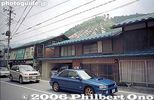
Held during late April to early May, Kanna's Koinobori festival of carp streamers is this town's claim to fame. About 800 colorful carp streamers swim in the sky above a river. Strings of carp streamers viewable from the road.
|
|
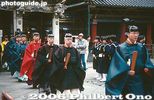
Also called "Sennin Gyoretsu" (1,000-person Procession 千人行列), this is Nikko's largest festival held on May 17-18. The highlight is a long procession of over 1,000 people dressed in various costumes.The three portable shrines are dedicated to the spirits of Tokugawa Ieyasu, Toyotomi Hideyoshi, and Minamoto Yoritomo. Photos start with May 17 at Toshogu Shrine, when priests gathered for a ceremony. 発興祭
|
|
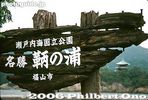
Sign for Tomonoura. Tomonoura is a National Important Traditional Townscape Preservation District (重要伝統的建造物群保存地区).
|
|
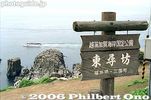
Tojinbo sign indicating the Echizen-Kaga Coastal Quasi-National Park
|
|
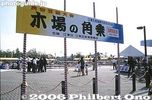
Kiba Park with Kiba Kakunori sign. Traditional folk performances are held on the same day as Koto Ward's Citizen's Festival in mid-Oct. So the park is quite crowded.
|
|

Haneda to Tokushima
|
|
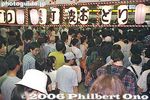
Crowd at JR Koenji Station on Awa Odori night.The Koenji Awa Odori is basically a parade of dancers. Many groups of dancers from various parts of Japan participate in the parade that follows the main shopping streets near Koenji Station on the Japan Railways Chuo Line in Tokyo.
|
|

Kenrokuen is one of Japan's three most famous gardens (besides Korakuen in Okayama and Kairakuen in Mito, Ibaraki). The garden was originally the castle garden for Kanazawa Castle. Katsurazaka Entrance to Kenrokuen Garden 桂坂口
|
|
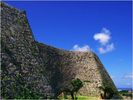
Nakagusuku Castle is part of a World Heritage Site of Okinawan gusuku castles. This is a view looking eastward from the base of the 3d enclosure (migusuku). Photos in this album all by Michael Lynch. Constructed in mid-fourteenth century of limestone rocks, placed without the use of mortar, Commodore Perry praised the construction technique on his visit to Okinawa in 1853.
|
|
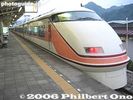
Tobu Line train to Nikko. It takes about 2 hours from Asakusa, Tokyo.
|
|

JR Chiba Station and Yokosuka Line
|
|

Before 8 am: Women do a warm-up lap.It wasn't exactly warm, but they had wet suits. Odaiba's water is not exactly crystal-clear clean either.
|
|

Established in 1617, Tsukiji Hongwanji temple is the Tokyo headquarters of the Nishi Hongwanji Jodo Shinshu sect. The present temple, based on Indian architecture, was built in the 1930s.The temple is the only one in Japan which is under the direct control of the sect. Its head priest is the Monshu Abbot himself. April 8 is observed as Buddha's birthday, called Hana Matsuri ("Flower Festival) in Japan.
|
|

Yasukuni Shrine is Japan's most prominent shrine for the war dead. Near Kudanshita Station on the Tozai Subway Line. This is the first giant torii
|
|

Very little remains of Otowa castle originally built by Lord Gamou Sadahide. Two battles took place here in 1496 and 1503. Road to Otowa Castle on the hill seen on the left.
|
|

Hino was home to many Omi merchants who plied up and down Japan during the Edo Period to sell and trade their wares. They became quite successful selling medicines, lacquerware, sake, etc. Those from Hino were called Hino shonin (Hino merchants).
|
|

Hino's most prominent shrine is best known for the Hino Matsuri festival on May 2-3. The shrine was originally atop Mt. Watamuki, Hino's tallest mountain. It was moved to its present location in 796.
|
|
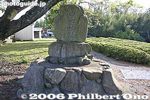
Nakano Castle, also known as Hino Castle, built in 1534 by Lord Gamou Sadahide (1508-1579). In 1582, when Oda Nobunaga was assassinated in Kyoto, Lord Gamo Katahide brought Nobunaga's wife and children from Azuchi Castle to Hino Castle for their safe
|
|

Torokko train at Arashiyama for Hozu Gorge
|
|
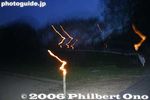
Held annually on May 4, the Misaki Shrine Fire Festival (hi-matsuri) has local people carry 2-meter long torches from their homes to the shrie where a 5-meter tall pile of bamboo is lit to make a towering inferno.A taiko drum is also carried and beaten.
|
|

Yasukuni Shrine during the Mitama Matsuri before dark.
|
|

Inuyama Yuen Station. Closest station to Inuyama Castle on the Meitetsu Line.
|
|

Road to Inuyama Castle
|
|

Three boats are used for the trip, sighted here off shore near JR Hira Station on the Kosei Line. 湖西線比良駅の沖
|
|

On the Sunday before the second Monday of Jan., 33 hectares of a hill called Wakakusa-yama (seen in the distance here) next to Nara Park is burned at night.The burning hill looks more spectacular from afar, but we went up close.
|
|

Held for two evenings on Aug. 14-15 during the obon season, people light their torches at Gosha Shrine and proceed to Hibarino park where the torches are thrown up to a large pine tree. The more torches get stuck on the tree, the better the next harvest.This is Hibarino park. The pine tree on the right of the small hill is the target for the torches. This park also serves as the Otabisho during the Hino Festival.
|
|

Nose Myokenzan Betsuin at a street corner. In Feb., priests at this small temple splash cold water on themselves for 30 min. Near Honjo-Azumabashi Station on the Toei Asakusa Line or JR Kinshicho Station on the Sobu Line.
|
|

Well-wishers look on as rowers embark for the race taking place at the same venue where the rowing competition was held at the 1964 Tokyo Olympics.
|
|

Kanayama Jinja Shrine is a small shrine within the grounds of the Wakamiya Hachimangu Shrine near Kawasaki Daishi Station. On the first Sun. of April, it holds this now-famous Kanamara Festival nicknamed the Phallus or Fertility Festival. Festival starts at 11 am. But a large crowd was already there well before that time. Entrance to shrine on the day of the Kanamara Festival. (If you're below age 18, please leave now.)
|
|
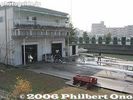
Seta Rowing Club's 2-story clubhouse located in Otsu, Shiga Prefecture. The club is a registered NPO. The club is named after Seta River at the southern tip of Lake Biwa. Regattas are also held on the river, Lake Biwa's sole outflowing river.
|
|

Bird's eye view of Shirakawa-go from Ogimachi Castle ruins.
|
|

Side view of Wada-ke House
|
|

Chiba Castle as seen from Kencho-mae monorail station.
|
|

Gate to Kitain, a Tendai Buddhist temple. Part of Kawagoe's National Important Traditional Townscape Preservation District (重要伝統的建造物群保存地区).
|
|

JR Nagano Station festooned with Olympic logos.
|
|
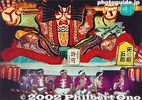
Nebuta are giant, wire-frame, paper lanterns shaped in various legendary and macho characters.The Aomori Nebuta Matsuri is held in Aomori City in Aomori Prefecture during Aug. 2-7. Nebuta are giant, wire-frame, paper lanterns shaped in various legendary and macho characters such as samurai warriors, demons, and gods. They are fantastic works of art dramatically illuminated from the inside. The floats are paraded along the main streets of the city near Aomori Station every night of the festival.
From August 2 to 6, the Nebuta parade is held from 7 p.m. to 9 p.m. On the 2nd and 3rd, the parade is geared for the many children who participate by pulling the floats. About 15 large Nebuta floats and some small Nebuta floats for the children are paraded.
The festival's peak period is from the 4th to the 6th when over 20 large Nebuta floats make their rounds. Be sure to see the festival on one of these three nights.
On the 7th, the last day, the parade is in the afternoon from 1 p.m. to 2:30 p.m. Later in the evening, the Nebuta floats are put on boats to be highlighted by a fireworks display.
The festival is designated by the government as an Important Intangible Folk Culture Asset and not to be missed if you have the chance. It's well worth the trip up north.
|
|

PR poster designed by Tetsuo OshiroPoster for the race.
京都大学ボート部OBの尾城徹雄様に作成したポスター。大学内や大津市石山商店街などで張り出された。
|
|

From late April to early May, five long strings of giant carp streamers swim in the air high above the Sagami River in Sagamihara, Kanagawa. This event was started in 1988.
|
|

Keisei Narita Station. Getting to Narita is cheaper via Keisei Railway.
|
|

The biggest taiko drum festival in the Kanto region is held annually in April. Various taiko drum troupes perform for two full days on various outdoor stages in Narita, including the main stage in front of the Narita-san temple.
|
|
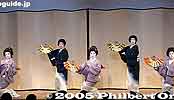
"Hana no Kai" Dance by Kagurazaka geishaThe "Hana no Kai" geisha dance is held annually by geisha in Kagurazaka, one of Tokyo's major geisha districts. "Hana" means livley or gaudy. And "Kai" can mean gathering or party.
They held two shows on the same day. This was the second show starting at 3 pm on April 16, 2005. It lasted till about 4:45 pm.
|
|

JR Kofu Station
|
|

Shirakawa-go is also a National Important Traditional Townscape Preservation District (重要伝統的建造物群保存地区).
|
|
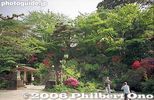
Garden
|
|

Strings of carp streamers latched to the ground from the mountaintop.
|
|
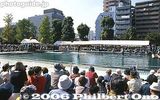
Huge crowd at Kakunori pond in Kiba Park.
|
|
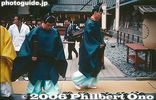
Prayer ceremony by priests
|
|

Ferry between Tomonoura and Sensui island.
|
|

Tojinbo in Mikuni-cho is spectacular, natural rock columns and walls on the coast. Hiking trails and boat rides give you a closer look at this rare natural monument. Tojimbo is accessible by bus from JR Awara Onsen Station on the Hokuriku Line.
|
|

Hi Philbert! Welcome aboard!
|
|

Each dance troupe starts with a lantern bearer showing the name of the troupe.The dance is quite simple. While bobbing up and down, the dancer holds her hands above the head and shakes the fingers. This hand gesture indicates that the person has gone crazy. It is therefore nicknamed the "fool's dance." The dance is held on the last weekend in August.
|
|

World Heritage Marker. Photo copyright 2009 Michael Lynch.
|
|

Entrance to Inohana Park
|
|

Inside Tobu Line train
|
|

Women at the starting line for triathlon
|
|

Kenrokuen is classified as a "kaiyu-shiki teien" (回遊式庭園) or "circular-strolling Japanese garden." It's a common and classic Japanese garden design where you simply walk around the garden, usually around a central pond.
|
|

Tsukiji Hongwanji temple gate with wisteria crest.The emblem is a wisteria flower and symbol of the Jodo Shinshu sect.
|
|

Path to shrine
|
|

Barrels of Hino merchant sake
|
|
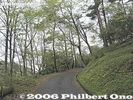
The castle is somewhat out of the way. It's a 15-min. walk from the nearest bus stop.
|
|

Later the shrine became Lord Gamou's family shrine and it was revered by Hino merchants during the Edo Period. This is the Shrine grounds. Map
|
|

The castle was abandoned in 1597. Only a few stone walls and shrines remain adjacent to Hinokawa Dam. This is one entrance to Nakano Castle. Map
|
|
|
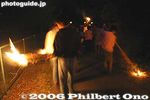
Procession of local residents carrying torches to the shrine. Map
|
|

Being my first regatta, I was at first daunted by the rowing terminology for the different types of boats.
|
|
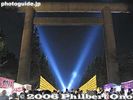
Yasukuni Shrine's main torii during Mitama Matsuri
|
|

Kiso River with Inuyama Castle in the distance
|
|

Inuyama Cultural History Museum犬山市文化史料館
|
|

Arriving Omi-Maiko on Day 1. Rowing around the lake has been an annual tradition.
|
|

Wakakusa-yama hill in JanuaryWakakusa-yama hill actually has three hills. We see only the first one here.
|
|

Entrance to Gosha Shrine. 五社神社
|
|

Shrine hall
|
|

Finish line end of the 2000-meter Toda Boat Course.
|
|

Shrine banners and cherries in full bloomThe red banner says "Kanayama Jinja" with an phallus (erect) logo on the top.
|
|
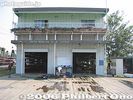
Seta Rowing Club's clubhouse. Boats are stored on the bottom floor, while the 2nd floor has office space, ergo machines, meeting room, locker room, etc. Web site here
|
|

Path to Wada House entrance
|
|

JR Chiba Station platform
|
|

Kitain Main hall, Kawagoe
|
|

Welcome sign at Nagano Station
|
|

The shrine also holds the Hino Matsuri on May 2-3.
|
|

There are five rows of streamers. In Japan, the koi carp is regarded as a symbol of valiant manhood because it swims up the river against the rapids.
|
|

"Blue Ocean Waves" (青海波)They performed four numbers. This first one was called "Blue Ocean Waves" performed by five geisha.
|
|
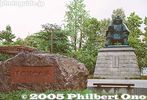
Park in front of Kofu Station.
|
|

Keisei Narita StationThe Narita City Hall can be seen with the green, temple-like roof.
|
|
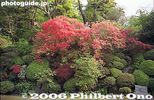
Garden (photos taken in early May)
|
|
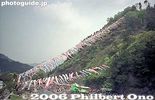
Eight strings of carp streamers hover over the river.
|
|
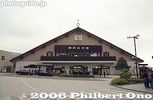
Tobu Nikko Station 東武日光駅
|
|
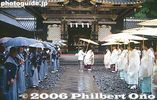
In front of the portable shrine storehouse for the three mikoshi. A ceremony is held to transfer the spirits from the main shrine to the portable shrines. 神輿舎にて宵成渡御This building is right next to the famous Yomei-mon Gate at the Toshogu Shrine.
神輿舎にて宵成渡御
|
|
|
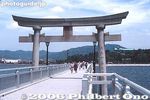
Torii on Takeshima island
|
|

Huge rock columns stand about 9 stories (25 meters) high.
|
|
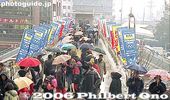
Nagano Station, East Exit to Olympic PlazaAt the East Exit of Nagano Station, this bridge, lined with advertising banners, led the way to the Olympic Plaza which featured ten tent pavilions made by official sponsors.
|
|
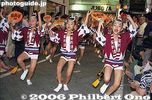
The troupe can consist of children (as young as age 2 or 3), women, and men.The Awa Odori originated 400 years ago in Tokushima Prefecture (in Shikoku) where it is one of Japan's most famous festivals. Although it is not as large as the one in Tokushima, the Koenji Awa Odori in Tokyo has become a major summer festival in Tokyo.
|
|
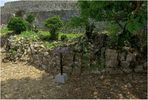
Sacred Site. There are eight special places of worship (Utaki) located within the castle walls. This view looks toward the East from the inside of the 1st enclosure. Photo copyright 2009 Michael Lynch.
|
|

Path to Chiba Castle (visible on left)
|
|

Temple gate and flag
|
|
|
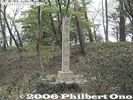
The castle met its demise in 1522 less than 60 years after it was built, after a war within the Gamou Clan. It now serves as a large hilltop park with good views of the surroundings. Otowa Castle marker
|
|
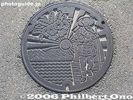
Manhole with the symbol of Hino merchant, Shiga Prefecture
|
|

Torii at Umamioka Watamuki Shrine in Hino, Shiga Pref.
|
|

Path to Nakano Castle ruins
|
|
|
|

Carrying back a single sculling boat
|
|

Promenade to the shrine
|
|
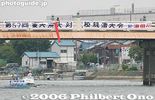
Karahashi Bridge as the starting point for alumni races
|
|

Inuyama Castle
|
|

Karakuri Doll Museumからくり展示館
|
|
|

Dry grass ready to burn...
|
|

Barrels of cold water in front of shrine
|
|

Gosha Shrine torii
|
|

End of the Toda Boat Course, near the 2000-meter finish line.
|
|

Pumping (or humping) the...
|
|
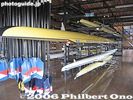
Oars and boats stored on the bottom floor. The club offers 2-hour rowing lessons on Sundays during May to Nov. Address: 6-1 Ogaya, Otsu, Shiga 520-2144 Japan. Phone/Fax: 077-545-9961, Email: info@setarc.jp
|
|

Close-up of Ogimachi
|
|

Main house on left and latrine on right with large vats to gather fertilizer.
|
|
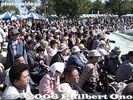
It starts at 11 am, so if you want a good view, go there early.
|
|
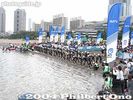
Starting line
|
|

Looks like Suganuma, another village in Gokayama area.
|
|

JR Chiba Station
|
|

Chiba Park approach
|
|

Main hall
|
|

The cable length is 250 meters and 13mmm thick. There are about 1,200 carp streamers. They are reused every year and donated by local families. (I also noticed a few advertising carps.)
|
|

JR Narita Station
|
|

Notice that the kimono design shows waves.
|
|

Statue of Takeda Shingen.
|
|
|
|
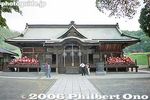
Shorinzan Daruma Temple 少林山達磨寺Daruma offerings on both sides of the temple.
|
|
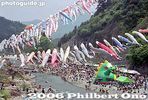
These pictures were taken in May 2003, when Kanna-machi town was newly formed upon the merging of Manba town and Nakazato village.
|
|

Shinkyo Sacred Bridge, Nikko 神橋
|
|
|
|
|
|
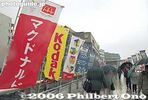
To Olympic Plaza
|
|

The Koenji Awa Odori has become a major summer festival in Tokyo. It had a humble beginning in 1957 when it was originally called the Koenji Baka Odori. "Baka" means fool.
|
|
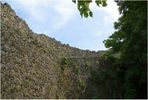
A view from the base of the West enclosure. Constructed in mid-fourteenth century of limestone rocks, placed without the use of mortar, Commodore Perry praised the construction technique on his visit to Okinawa in 1853. Photo copyright 2009 Michael Lynch.
|
|

Chiba Castle and paper lanterns
|
|

Kiba Sqaure Log Rolling is performed by the Kiba Kakunori Hozon-kai or Preservation Society. 木場角乗保存会
|
|

8:10 am: And they're off, taking about 30 min. to swim 1.5 km.
|
|

Play room for kids on Hanamatsuri
|
|

Statue of Omura Masujiro (1824-1869) 大村益次郎, founder of Japan's modern army. Also pushed for the establishment of Yasukuni Shrine.
|
|

Suzuka Quasi-National Park markerThe area is within this park.
|
|

Omi Hino Merchant House. The former home of Hino merchant Yamanaka Hyouemon was donated to the town in 1981. Now a museum exhibiting the history and artifacts of the Hino merchants. 近江日野商人館Small admission charged. Open 9 am to 4 pm, closed on Mon. and Fri. Close to the center of town.
Address: Okubo 1011, Hino-cho
Phone No.: 0748-52-0007
山中兵右衛門
|
|

Stone bridge
|
|
|
|
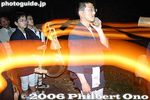
The torch procession rings out.
|
|

The place was not as crowded as you would think.
|
|

Spotlights create a silhouette of the statue of Omura Masujiro (1824-1869) 大村益次郎, founder of Japan's modern army.
|
|

Inuyama Castle
|
|

Karakuri Doll MuseumThe karakuri dolls, set atop ornate floats, are controlled with strings.
|
|

They use four-man boats (called "knuckle four" in Japanese) with sliding seats. It is stable and safe, ideal for beginners.
|
|

Volunteer firemenThe hill set alight by 300 volunteer firemen and prefectural workers who climb up the hill.
|
|
|

Barrels of cold water
|
|

Housing for visiting rowing teams whose school flags are displayed.
|
|

Plum Blossom Queen at Kairakuen StationShe was passing out maps of the garden. It was a nice touch to see two of these kimono beauties greeting us.
|
|

The festival is wildly popular with people from overseas.The shrine had various phallus props to pose with.
|
|
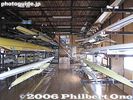
Many boats are made in Italy.
|
|

Main house with a recently rethatched roof, making it look very smooth.
|
|
|
|

JR Chiba Station
|
|

Pagoda at Kitain temple, Kawagoe
|
|
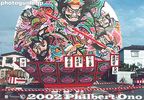
Fan-shaped Neputa float.The painted picture on the front of the Neputa depicts mostly warriors and on the back are beautiful courtesans.
|
|
|
|
|

An Australian praying at the temple
|
|
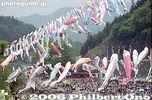
I would say this is one of Japan's top five best places to see carp streamers at Kanna-machi, Gunma.
|
|

To mark the song's 100th anniversary, a new song monument was unveiled at Kyoto University (Yoshida-South Campus) on Nov. 25, 2017.
|
|
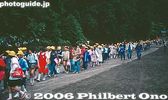
Kids on school trip along Omotesando 表参道
|
|

The three portable shrines (mikoshi) are then carried out of the storehouse to be taken to Futarasan Shrine.
|
|
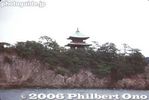
Bentenjima island near Tomonoura.
|
|

Bungee jumping is probably not possible here.
|
|
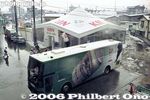
Pavilion by Kirin Brewery.Notice the "wrap" bus passing in front.
|
|
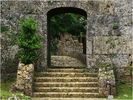
Rear Gate. Most visitors will enter through this gate to the castle, as it is closest to the parking and ticket sales. Photo copyright 2009 Michael Lynch.
|
|

Chiba Castle Sakura Matsuri lantern
|
|

Kiba used to be where wood and lumber were stored and produced. 相乗り
|
|
|
|

Hanamatsuri altar
|
|
|

Entrance to castle grounds, now a picnic and playground.
|
|
|
|

Stone bridge
|
|

Nakano (Hino Castle) in Hino, Shiga Pref. The castle was built in 1534 by Lord Gamou Sadahide (1508-1579).
|
|

Hozu River
|
|

Towering inferno of bamboo on fire. The shrine has a 5-meter tall pile of bamboo which is lit to make a towering inferno within the shrine grounds. Very dramatic.
|
|

Rowing team from Nagahama
|
|

A bon dance around the base of the statue.
|
|

Kyoto Univ. in dark blue T-shirts
|
|

Shimizu Bank
|
|

Haritsuna Shrine
|
|

Entrance to Urakuen GardenThis garden has a few tea houses including one called Jo-an, a National Treasure. THe garden is close to Inuyama Castle and worth a visit. Admission 1,000 yen.
有楽苑
営業時間 9:00〜17:00(3/1〜7/14 ・ 9/1〜11/30)
9:00〜18:00(7/15〜8/31)
9:00〜16:00(12/1〜2/末日)
休日 無休 入場料 大人1,000円(呈茶別500円)
〒484−0081
愛知県犬山市御門先1
TEL 0568(61)4608
交通 名鉄犬山線犬山遊園下車徒歩7分
|
|

Each boat has four rowers and cox who steers the rudder.
|
|

Bamboo torches and bamboo broomsThe bamboo torches is filled with kerosene and plugged with cotton cloth. They are used to set the hill afire. The bamboo brooms are used to spread the fire or extinguish it. The brooms burn up by the end of the festival.
|
|

The congregation gather on the steps and beat fan-shaped drums.
|
|
|

Plum Blossom Queen
|
|

Boat landing near finish line.
|
|

Dickhead hat. Actually, I don't know what they call it, but that's what I call it.
|
|

One trademark of the dancers is the crescent-shaped straw hats.
|
|
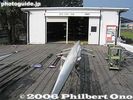
Right across the clubhouse is the Annex boat house.
|
|

Shirakawa-go 白川郷
|
|

Wada House, Shirakawa-go
|
|

Entry road to Ainokura village. Bus stop shelter on right.
|
|

White weeping cherry blossoms
|
|
|
|

Rear view
|
|
|
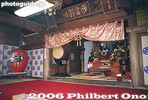
Inside the Daruma temple, Takasaki.
|
|
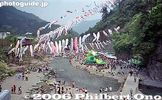
Kanna-machi is quite out of the way, but worth the time it takes to get there (from Takasaki).
|
|

Front side of the monument has the Japanese lyrics and explanation of the song. Monument is made of stainless steel with a brushed-metal finish.
|
|
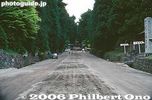
A National Treasure and World Heritage Site, Nikko's magnificent shrines and temples overshadow any other attractions Tochigi has. The Toshogu Shrine is especially famous and also serves as Tokugawa Ieyasu's mausoleum. Omotesando 表参道
|
|
|
|
|

Olympic PlazaSnowlets House and Kodak's pavilion behind it.
|
|
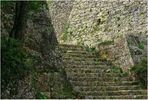
Stone Stairs. They lead to the 2nd enclosure. Visitors should wear sturdy walking shoes, as the stone-lined pathways and stairs can be very difficult to walk on without twisting an ankle. Photo copyright 2009 Michael Lynch.
|
|

Chiba Castle tower
|
|

Men managing the logs in the river eventually developed their own log tricks while on the job.
|
|
|
|

Pouring sweet tea over the BuddhaWhen the Buddha was born in Lumbini Garden in Nepal, sweet rain is said to have fallen. Thus, sweet tea is poured over the baby Buddha statue in the Hanamatsuri altar.
|
|

Second torii
|
|

Castle monument
|
|

Inside Omi Hino Merchant House近江日野商人館
|
|
|
|
|

Hozu Gorge
|
|
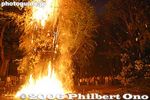
Misaki Shrine Fire Festival in Aisho. The shrine has a 5-meter tall pile of bamboo which is lit to make a towering inferno within the shrine grounds. Very dramatic. Also see the video at YouTube.
|
|
|
|
|

Sanko Inari ShrineThe shrine provides a short cut to the castle.
|
|

Urakuen Garden水琴窟
|
|

The green boat. 近江舞子上陸
|
|
| 29599 files on 118 page(s) |
1 |
 |
 |
 |
 |
|